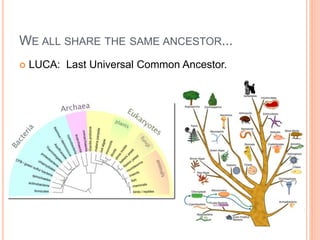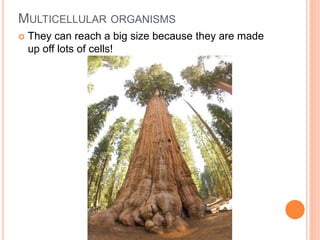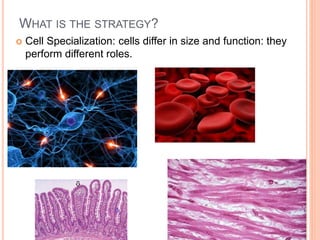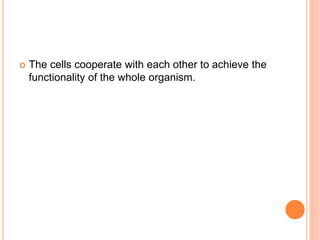Cells
- 2. All organisms are made up of cells. The smallest functional and structural unit.
- 3. WHAT DO CELLS HAVE IN COMMON? DNA The genetic material that provides instructions for all cell processes. Prokaryotic Eukaryotic DNA is not contained in DNA is contained in an a nucleus. organelle called nucleus.
- 4. Cytoplasm Includes the fluid and the organelles. Organelles Specialized to perform a specific function. Cell Membrane A protective layer that controls the materials that enters or exit the cell.
- 5. EUKARYOTIC CELLS Animal Plant Mitochondria: cellular respiration. Ribosomes: makes proteins. Endoplasmatic Reticulum: makes proteins or lipids. Golgi Complex: deliver proteins and lipids. Lysosomes: contains Cell Wall: provides digestive enzymes . support. Large vacuola: storage. Chloroplasts: photosynthesis.
- 6. HOW WAS THE EUKARYOTIC CELL ORIGINATED? Endosymbiotic Theory
- 7. Videos
- 10. EVIDENCE? Membranes DNA Reproduction
- 11. WE ALL SHARE THE SAME ANCESTOR... LUCA: Last Universal Common Ancestor.
- 12. FROM UNICELLULAR TO MULTICELLULAR Unicellular: Eukaryotic Prokaryotic
- 13. When a cell grows in size it needs more nutrients and produces more waste. In addition the internal organization of the cell gets more complicated because all functions are disperse in a bigger space. It is necessary that cellular size is mantein small to favour reactions and exchange with the outside.
- 15. MULTICELLULAR ORGANISMS They can reach a big size because they are made up off lots of cells!
- 16. WHAT IS THE STRATEGY? Cell Specialization: cells differ in size and function: they perform different roles.
- 17. The cells cooperate with each other to achieve the functionality of the whole organism.
















